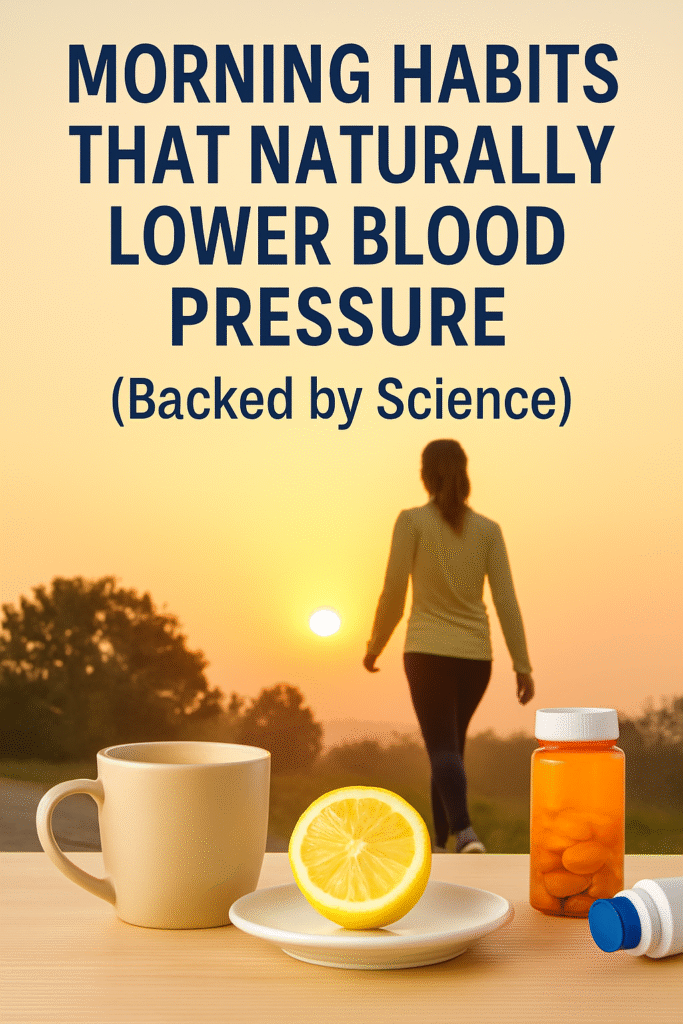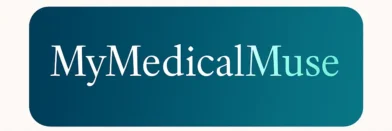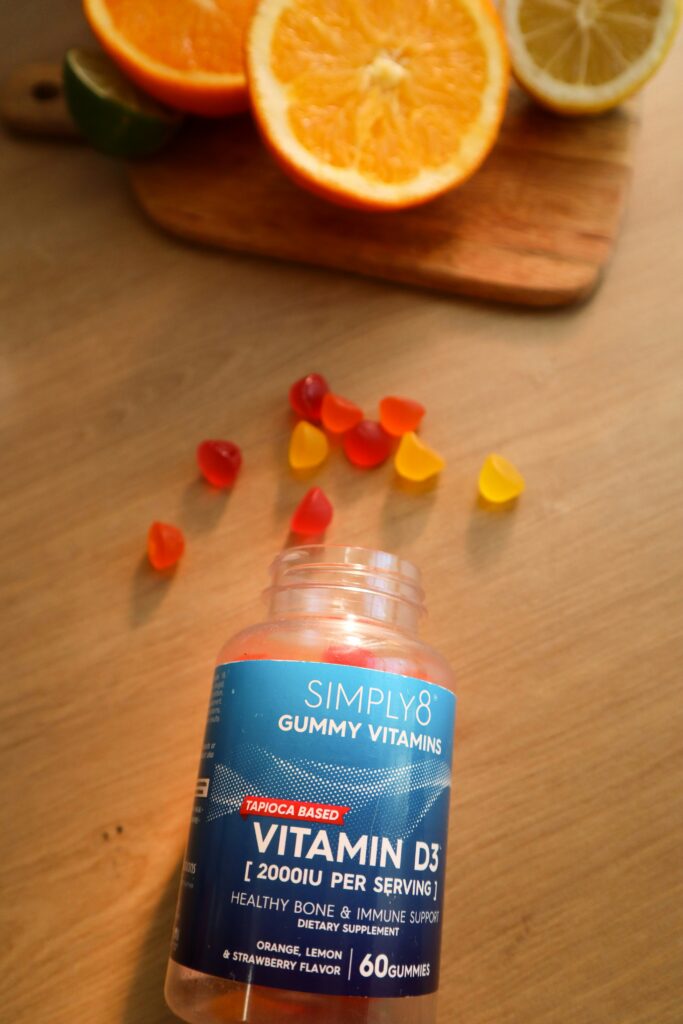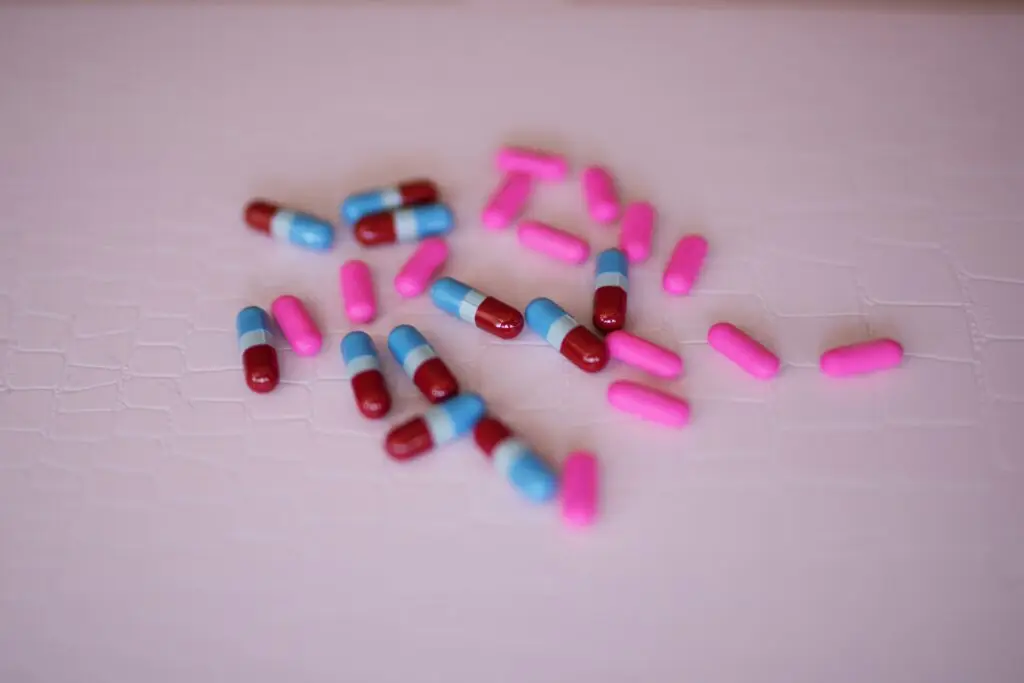
⚠️ Affiliate Disclaimer: This post may contain affiliate links, which means I may earn a small commission — at no extra cost to you — if you make a purchase through one of these links. I only recommend products or services I genuinely trust and believe can provide value. Thank you for supporting My Medical Muse!
Morning Habits That Naturally Lower Blood Pressure (Backed by Science)
Table of Contents:
- 1. Introduction: High Blood Pressure Doesn’t Wait for Nightfall
- 2. Why Mornings Matter for Your Blood Pressure
- 3. Wake Up Gently, Not Jarringly
- 4. Hydrate Before You Caffeinate
- 5. Add a Dash of Lemon or Apple Cider Vinegar
- 6. Practice Morning Gratitude or Prayer
- 7. Try Simple Deep Breathing or Meditation
- 8. Go for a Morning Walk or Do Light Stretching
- 9. Eat a Heart-Healthy Breakfast
- 10. Get Some Natural Morning Sunlight
- 11. Take Your Prescribed Medications (If Any) on Schedule
- 12. Limit Morning News and Social Media Stress
- 13. Morning Supplements That Support Healthy Blood Pressure
- 14. Bonus Tip: Start a Morning Routine Tracker
- 15. Final Thoughts: Rewire Your Mornings, Transform Your Health
Introduction: High Blood Pressure Doesn’t Wait for Nightfall
High blood pressure, or hypertension, is often called the “silent killer” because it can quietly damage your arteries, heart, and kidneys without obvious symptoms, but what many people don’t realize is that blood pressure isn’t static, it fluctuates throughout the day, and mornings are often the most vulnerable time.
This phenomenon, known as the morning blood pressure surge, is a natural part of your body’s circadian rhythm. However, for individuals with hypertension, this surge can be exaggerated, increasing the risk of heart attacks, strokes, and other cardiovascular events.
According to the American Heart Association, nearly half of adults in the U.S. have high blood pressure, and only about 25% have it under control. That’s a staggering statistic but it also means there’s a huge opportunity for change.
The good news? You don’t need expensive treatments or complicated routines to make a difference. Small, intentional morning habits can help regulate your blood pressure and set the tone for a healthier day.
Why Mornings Matter for Your Blood Pressure
Your body is a finely tuned machine, and mornings are when it revs up for the day. Upon waking, several physiological changes occur:
- Cortisol and adrenaline levels rise to energize you
- Blood vessels constrict, increasing vascular resistance
- Heart rate increases, boosting cardiac output
These changes are normal, but in people with hypertension, they can be amplified. This is especially true for those with sleep disorders, diabetes, or chronic stress. A 2006 study published in Hypertension found that individuals with elevated morning blood pressure were significantly more likely to experience cardiovascular events even if their readings normalized later in the day.
That’s why your morning routine isn’t just about productivity it’s about protection. The first few hours after waking can either trigger stress or promote healing.
1. Wake Up Gently, Not Jarringly
How you wake up sets the tone for your entire day. A blaring alarm jolting you out of deep sleep can activate your sympathetic nervous system, triggering a fight-or-flight response.
This sudden stress response causes:
- A sharp spike in blood pressure
- Increased heart rate variability
- Constricted blood vessels
Instead, try these gentler wake-up methods:
- Sunrise alarm clocks that simulate natural light and gradually brighten your room
- Nature sounds like ocean waves, birdsong, or rainfall
- Stretching in bed before standing, wiggle your fingers and toes, roll your ankles, and sit up slowly
This gentle transition helps your body shift from rest to wakefulness without unnecessary stress.
2. Hydrate Before You Caffeinate
After 6-8 hours of sleep, your body is naturally dehydrated. Dehydration causes your blood to become more viscous and your blood vessels to constrict both of which raise blood pressure.
Drinking 16-20 ounces of water first thing in the morning:
- Improves blood flow
- Supports kidney function
- Helps maintain electrolyte balance
Keep a water bottle on your nightstand and drink before getting out of bed. This can also help prevent orthostatic hypotension, a sudden drop in BP when standing. While coffee is fine in moderation, caffeine can temporarily raise blood pressure, so hydrate first, then sip your brew.
3. Add a Dash of Lemon or Apple Cider Vinegar
Enhance your morning hydration with a splash of lemon or a teaspoon of apple cider vinegar (ACV). These simple additions offer powerful health benefits.
Apple Cider Vinegar
- Contains acetic acid, which may help regulate the renin-angiotensin system, a key player in blood pressure control
- May reduce fasting blood sugar, indirectly improving vascular health
Lemon
- Rich in vitamin C, a potent antioxidant that supports arterial flexibility
- Acts as a natural diuretic, helping reduce fluid retention and lower BP
This combo also aids digestion and liver detoxification, giving your body a clean start.
4. Practice Morning Gratitude or Prayer
Gratitude isn’t just a feel-good emotion, it has measurable effects on your physiology. Research in the Journal of Psychosomatic Research shows that people who practice gratitude regularly have:
- Lower levels of inflammation
- Improved heart rate variability
- Better blood pressure regulation
Try starting your day with:
- A short prayer or spiritual reflection
- A gratitude journal listing 3 things you’re thankful for
- A moment of mindfulness focused on peace and surrender
This practice rewires your brain and nervous system, reducing stress and promoting cardiovascular health.
5. Try Simple Deep Breathing or Meditation
You don’t need to sit cross-legged for an hour to benefit from meditation. Even 5 minutes of focused breathing can make a difference.
Box Breathing Technique
- Inhale for 4 seconds
- Hold for 4 seconds
- Exhale for 4 seconds
- Hold for 4 seconds
- Repeat for 5 minutes
Apps like Insight Timer, Headspace, and Breethe offer guided sessions tailored to beginners.
Scientific studies show that deep breathing:
- Reduces cortisol levels
- Lowers blood pressure by 5-10 mmHg
- Increases nitric oxide, which relaxes blood vessels
Pair breathwork with calming music or nature sounds for enhanced relaxation.
6. Go for a Morning Walk or Do Light Stretching
Physical activity is one of the most effective natural treatments for high blood pressure. Morning movement helps regulate your circadian rhythm and sets a positive tone for the day.
Benefits of morning exercise:
- Stimulates nitric oxide production, relaxing arteries
- Improves insulin sensitivity, reducing inflammation
- Lowers cortisol over time
Try:
- A 20-minute brisk walk
- 10 minutes of tai chi or qigong.
- Gentle yoga poses like cat-cow, forward folds, and child’s pose.
- Rebounding on a mini trampoline.
You don’t need to break a sweat consistency is key. Aim for 4-5 mornings a week.
7. Eat a Heart-Healthy Breakfast
Skipping breakfast or eating sugary, processed foods can spike your blood sugar and cortisol levels both of which affect blood pressure.
Avoid:
- Sugary cereals
- Processed meats like bacon and sausage
- White bread and pastries
Choose:
- Oats with flaxseed, cinnamon, and banana
- Eggs with sautéed spinach and avocado toast
- Greek yogurt with chia seeds, berries, and almonds
- Smoothies with beet powder, spinach, banana, and almond milk
Keep sodium intake below 1500 mg daily. Breakfast is a great place to start reducing salt.
8. Get Some Natural Morning Sunlight
Your body’s internal clock, or circadian rhythm, relies on light cues to regulate hormones and blood pressure.
Benefits of morning sunlight:
- Boosts vitamin D production, which supports BP regulation
- Enhances melatonin rhythm, improving overnight BP control
- Reduces symptoms of seasonal affective disorder, which can elevate BP
Aim for 10-20 minutes of direct or indirect sunlight between 6 a.m. and 10 a.m. Open your curtains, step outside, or take your walk in the sun.
9. Take Your Prescribed Medications (If Any) on Schedule
If you’re on blood pressure medication, timing matters. Skipping doses or taking them inconsistently can lead to dangerous fluctuations.
Tips for consistency:
- Use a pill organizer with day labels
- Set reminders on your phone or use medication apps
- Pair with a daily habit like brushing your teeth or making breakfast
Some medications (like ACE inhibitors or ARBs) are more effective when taken in the morning. Always follow your doctor’s instructions.
10. Limit Morning News and Social Media Stress
Your mental diet affects your physical health. Starting the day with stressful news or social media drama can spike cortisol and blood pressure.
Avoid:
- Doomscrolling headlines
- Reading toxic comments
- Checking emails before breakfast
Instead:
- Listen to a motivational podcast
- Play classical or lo-fi music
- Enjoy silence or nature
Morning Supplements That Support Healthy Blood Pressure
Some natural supplements have been shown to help regulate blood pressure when taken consistently. Morning is often the best time to take them, especially when paired with breakfast for better absorption.
Magnesium
Helps relax blood vessels, supports nerve and muscle function, and may lower both systolic and diastolic pressure. Look for forms like magnesium glycinate or citrate.
Coenzyme Q10 (CoQ10)
A powerful antioxidant that supports heart health and improves energy production at the cellular level. Studies suggest it may lower blood pressure by improving endothelial function.
Beetroot Powder or Capsules
Rich in nitrates, beetroot boosts nitric oxide levels, helping dilate blood vessels and improve circulation.
Omega-3 Fatty Acids
Found in fish oil, these healthy fats reduce inflammation, support artery health, and can lower triglycerides and blood pressure over time.
Hibiscus Extract or Tea
Known for its natural ACE-inhibiting properties, hibiscus may reduce hypertension in a manner similar to some medications.
Always check with your healthcare provider before starting new supplements, especially if you’re on medication.
Bonus Tip: Start a Morning Routine Tracker
If you’re serious about improving your blood pressure, consistency matters more than perfection. Tracking your morning habits helps build momentum and accountability.
Use a simple journal or app to log:
- Wake-up time
- Water intake
- Physical activity
- Meditation or prayer
- Breakfast choices
- Supplements taken
- Blood pressure readings (if you’re monitoring)
Apps like Habitica, Done, or even Google Sheets can turn your routine into a motivating checklist. Over time, you’ll start seeing patterns between your morning actions and how you feel throughout the day. That data is powerful.
Final Thoughts: Rewire Your Mornings, Transform Your Health
Managing high blood pressure isn’t just about pills and doctor visits. It’s a lifestyle. And it starts with your mornings.
Each of these habits might seem small on its own. But together, they create a rhythm that supports your nervous system, calms your mind, and strengthens your heart. By rewiring your mornings, you’re literally rewiring your health.
Let this be your new mantra: “Every morning is a new chance to choose health.”
Whether you’re just starting out or you’ve been on this journey for a while, remember this: progress, not perfection. Even one or two of these habits can make a real difference over time.
So tomorrow morning, when your alarm goes off or better yet, when the sunlight gently wakes you remember: your heart is counting on you and you’ve got this.
👩⚕️ Need Personalized Health Advice?
Get expert guidance tailored to your unique health concerns through MuseCare Consult. Our licensed doctors are here to help you understand your symptoms, medications, and lab results—confidentially and affordably.
👉 Book a MuseCare Consult NowRelated Post You Should Read:
- 10 Steps on How to Track Blood Pressure at Home Accurately
- Dehydration Headache? 10 Proven Ways to Stop It Fast & Stay Pain-Free
- 12 Powerful Health Benefits of Coffee Backed by Science
- Aspirin After Minor Stroke: 7 Powerful Facts You Must Know
- Can Intermittent Fasting Help Type 2 Diabetes? 9 Powerful Facts


